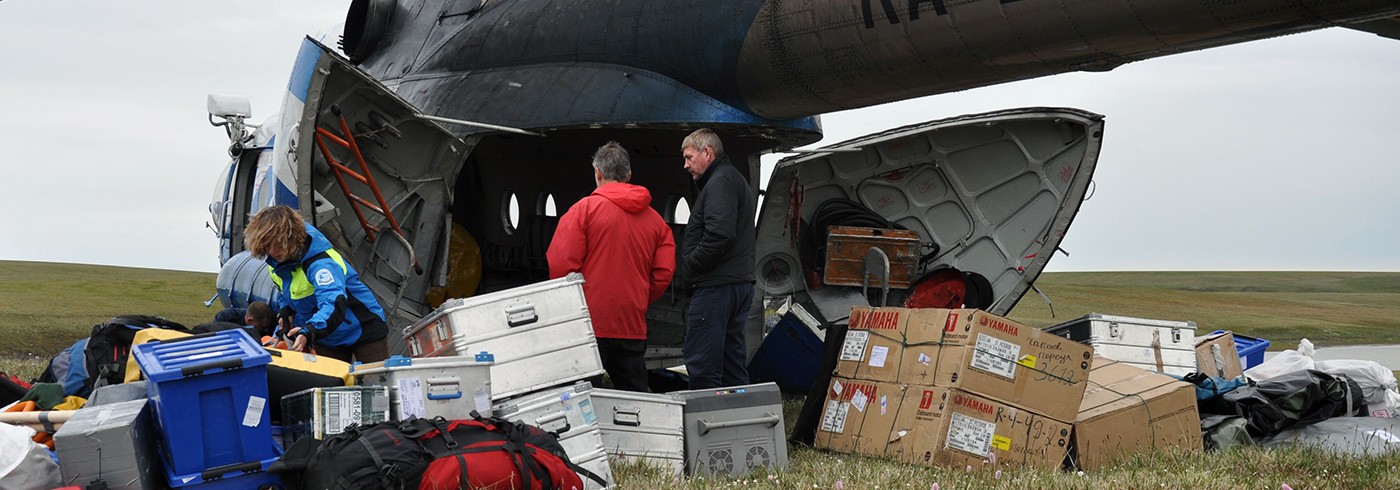
Matlagning. Foto: Per Möller
After the thunderstorm Sunday night the rain continued on and off on Monday until noon, and then blue skies again. All had a rest, sleeping until the brunch was served, and after that sorting up the mess after the storm. The evening was beautiful, comfortably warm and with a light breeze. We had our dinner outside on the river terrace; fried shir, boiled potatoes and melted butter, quite superb!

Middag. Foto: Per Möller
However, it was hot again on Tuesday, more than 25 °C. Four of us made a hike over the tundra for 7 km to a small lake between what I thought was highly situated beach ridges. This assumption was correct but the geologic result was poor as no sections and dateable material was at hand. It was tough going over the tundra, for 80 % wetland where your feet sink down a decimetre for each step; it just drags out your strength from your body, and then in this heat! I think I consumed four litres of water, and was quite exhausted when we came back to our boat after the 15 km walk.

Utanför tältet. Foto: Per Möller
Wednesday we were totally fogged in until noon, the sight length was only 50 m. Dima, Polina and Andrei prepared for a 4 days long trip to a lake some 30 km from our camp, first 30 km downstream the Taimyra River, and then carrying all their stuff for 12 km to the target lake. The aim was to make a lake coring, retrieving sediments from the lake bottom as far down in time as possible. On sat telephone at night we got the message that they did not make it to the lake the first day. The equipment was too heavy and the terrain too rough, so it actually took them two days to reach the lake, and the campaign had to be extended for another day. The reaction on the hot Tuesday weather came of course as thunder and heavy rain in the afternoon, but not at all in the dimensions as on last Sunday. Dima’s group sitting in a zodiac was soaked, whereas the rest of us were safe in our tents.
Thursday and Friday were nice days, a pale blue sky, not much wind, the landscape in a haze. Kenneth cored an ice-wedge complex just outside the camp, whereas I, Johanna and Martin made two long reconnaissance trips with one of our zodiacs. On Thursday we drove the Taimyra River 55 km downstream, on its way cutting through the wide moraine belt that we call the Upper Taymyr Ice Marginal Zone, a strand-still position for the ice sheet when it last was here. My purpose is of course to put an age on this event – I have an idea but not any proof. However, none what so ever sections along the river was at hand, so these proof have to be sought after at other places. So it was a long journey mostly for nothing – but a beautiful trip!

Blommor. Foto: Per Möller
On Friday we made another 55 km trip, but now upstream the Logata river, the river system that will be the last leg on the zodiac part of the expedition. A deep and easily navigable river so far up, but the current had its effect; up-streams our average cruising speed was 9 km an hour, whereas it was 15 km an hour down-stream! We localized two promising sections during the last 5 km of that trip and decided that this will be the goal for the next base camp.
Saturday was again a very warm day, no wind and a haze until the afternoon. However, a storm came in from the west in the afternoon with much more chilly winds, and we finally got a change in the weather system to more normal arctic conditions. The day was a preparation day for take off to camp 6, sorting up the food that was delivered to depot 2, pumping over fuel from barrels to canisters, etc. We also changed propeller on our boats; my judgement is that at around 25 % of their area was gone due to the tough going in sandy and gravelly river beds.

Tält. Foto: Per Möller
Our take-off from camp 5 will be a bit complicated. As the lake coring group comes in late Sunday night, and that we expect a Mi8 helicopter on Monday morning, retrieving the now empty fuel drums and garbage, taking out Dima to Khatanga, and taking Kenneth’s frozen sediments samples to a freezer and all my sediment samples for dating purposes to the same place. However, I, Johanna and Martin can not loose time doing nothing for two days, so the plan is that we sail with one boat to base camp 6, and then the others will catch up later when the exchange business is done at depot 2/base camp 5.
So Sunday morning our boat was packed and we sailed upstream Logata River to base camp 6, and settled after 50 km on a nice river terrace with one of our sections at eyes sight. On satellite telephone I got confirmation that Dima’s group was safe back at base camp 5 in the early evening, joining up with Kenneth, and preparing for helicopter exchange tomorrow. With this also comes new bread and fresh vegetables. The bread has been uneatable for the last two days, totally covered up in nice green mould. We have gone for pasta salad for lunches instead. With Dima and samples gone, the rest of the gang will join up tomorrow night at our new camp.
Per Möller, Lunds universitet

